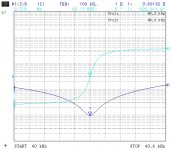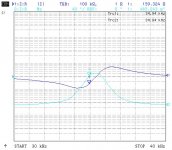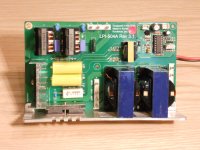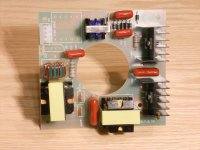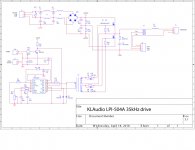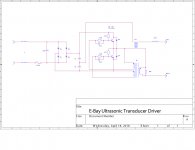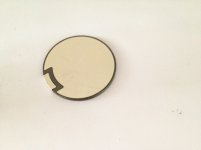Thanks a million BB, for this and the entire thread! I'm only about 10 years late to the party, but as they say bltn. I've been using a VPI HW-17f for years, but recently visited an audiophile who has the KL Audio us cleaner. I brought with me some high sound quality Mint LP's from my collection with which to evaluate his sytem (very nice---ARC 40rh Anniversary pre-amp, VTL power amps, Magico Q3 loudspeakers, an EAR-Yoshino Discmaster turntable with two arms, lomc cartridges), one of which he cleaned for me. Time for me to get with the program!
Sonix 4 confirmed the Amazon listing for 60 kHz is incorrect. Their reply:
Thank you for your inquiry.
We have 3 frequencies available on our tabletop machines: our E-Type is 40 kHz, our F-Type has dual-frequency of 28 kHz and 40 kHz, and our K-Type is 68 kHz.
Thank you for your inquiry.
We have 3 frequencies available on our tabletop machines: our E-Type is 40 kHz, our F-Type has dual-frequency of 28 kHz and 40 kHz, and our K-Type is 68 kHz.
I just heard back from SONIX IV technical support that the one I got may be the earlier version of 40 kHz. I am looking to buy their newer 68 kHz version and see if it cleans better.
What is a mastered CD? Many bollywood (indian) movies are making new LPs for old Albums. If you make LPs from digital audio, is it the same as makings LPs from analog audio. I thought that the whole point of LP was to get that dynamic range in the sound. They say human ear cannot make that distinction, but I enjoy LP music more than when played from other sources like DVD or youtube. Is this placebo or real.
Thanks
What is a mastered CD? Many bollywood (indian) movies are making new LPs for old Albums. If you make LPs from digital audio, is it the same as makings LPs from analog audio. I thought that the whole point of LP was to get that dynamic range in the sound. They say human ear cannot make that distinction, but I enjoy LP music more than when played from other sources like DVD or youtube. Is this placebo or real.
Thanks
Kanchi, Let us know what pricing they give you on the 68 kHz K-series cleaners. This seems to be pretty much a custom order item, as they don't keep them in stock as far as I have seen.
There are many other threads to cover the analog LP vs. digital debate so that probably shouldn't be dealt with in this thread on ultrasonic cleaning.
Cheers,
B B
There are many other threads to cover the analog LP vs. digital debate so that probably shouldn't be dealt with in this thread on ultrasonic cleaning.
Cheers,
B B
I will post the price of the 68 kHz.
Please link a few good threads covering LP vs digital debate.
Thanks
Please link a few good threads covering LP vs digital debate.
Thanks
Thanks BB, you're quite a guy! If one wants a 40Khz machine, I imagine the Sonix E-Type at $350 would be a fine choice. However, I think I'm going to go with either 60 or 80. Has a consensus been reached between the two, or even 135Khz? In my case, I'm not as concerned with the ability to clean really dirty records (thrift store finds, ebay, etc.), as all my LP's were bought (and will continue to be bought) either new or in Mint or Mint- condition. I'm looking for not just the cleaning that makes for quieter sounding LP's, but the cleaning that also affords improvement in sound "quality"---the very low-level, small signal sounds engraved in the groove.
Though I have loudspeakers with extended high-frequency response (ESL's and ribbon tweeters), 55 years of playing drums and attending live shows (The Ramones were insanely loud! Hendrix and Cream only moderately so.) has diminished my ability to hear much above maybe 10kHz. The audiophile who put my LP through his KL Audio us cleaner had not only Magico speakers (known for their "generous" high-frequency output and extremely high resolution---ruthlessly revealing), but also a pair of add-on super-tweeters. My VPI HW-17 cleaned LP's were surprisingly and distressingly noisy (not clicks and pops, but groove/vinyl "noise"---a "texture" added to the sound of vocals and instruments, a subtle "veil" imposed between recording and listener) on his system, which is when I realized I had to investigate us cleaning. I knew I wasn't going to spend $4k on a KL Audio or Audio Desk cleaner, not just because of the absurd price, but because of their failure rate and inability to be repaired. This thread is just what I needed to educate myself on us cleaning. Thanks one-and-all, BB especially, of course. It took me three days to read through it all---time well invested!
Though I have loudspeakers with extended high-frequency response (ESL's and ribbon tweeters), 55 years of playing drums and attending live shows (The Ramones were insanely loud! Hendrix and Cream only moderately so.) has diminished my ability to hear much above maybe 10kHz. The audiophile who put my LP through his KL Audio us cleaner had not only Magico speakers (known for their "generous" high-frequency output and extremely high resolution---ruthlessly revealing), but also a pair of add-on super-tweeters. My VPI HW-17 cleaned LP's were surprisingly and distressingly noisy (not clicks and pops, but groove/vinyl "noise"---a "texture" added to the sound of vocals and instruments, a subtle "veil" imposed between recording and listener) on his system, which is when I realized I had to investigate us cleaning. I knew I wasn't going to spend $4k on a KL Audio or Audio Desk cleaner, not just because of the absurd price, but because of their failure rate and inability to be repaired. This thread is just what I needed to educate myself on us cleaning. Thanks one-and-all, BB especially, of course. It took me three days to read through it all---time well invested!
I just heard back from SONIX IV technical support that the one I got may be the earlier version of 40 kHz. I am looking to buy their newer 68 kHz version and see if it cleans better.
Do you have the link to the Ebay auction whete you bought your US cleaner? A picture would help identify.
Personally I'm still a fan of the Sonix IV 60 KHZ units. I have bought several with different tank sizes off Ebay. I have two Vibrato's , 60 & 80 KHZ. The 80 KHZ unit is better for already "clean" records. Haven't used the 60 KHZ unit yet, but want to compare with the Sonix.
Last edited:
this is interesting, 695 zloty is around 170 euro:
Ultradźwiękowa myjka do płyt winylowych DIY auto Gdańsk Przymorze Małe • OLX.pl
most probably made in china.
Ultradźwiękowa myjka do płyt winylowych DIY auto Gdańsk Przymorze Małe • OLX.pl
most probably made in china.
Comments on this one (aside from the 40khz frequency issue)?
10L(2.5 gal) SS Digital Heater Ultrasonic Cleaning Machine - TheLAShop.com
10L(2.5 gal) SS Digital Heater Ultrasonic Cleaning Machine - TheLAShop.com
Hi Carl,
For my 2 cents, I'm dubious of the unit in your LAShop link. I see indications that this is a very cheaply made item. For example, their basket design rests on the bottom of the tank on some sort of rubber feet. That's a really bad idea. Baskets should hang from the top outside rim of the unit.
Also, the drain hose they show in one of the photos looks like the worst piece of tubing I've ever seen. It's collapsed in several places and looks next to useless.
I suspect a chance that actual delivered units might not even be true 40 kHz machines too.
B B
For my 2 cents, I'm dubious of the unit in your LAShop link. I see indications that this is a very cheaply made item. For example, their basket design rests on the bottom of the tank on some sort of rubber feet. That's a really bad idea. Baskets should hang from the top outside rim of the unit.
Also, the drain hose they show in one of the photos looks like the worst piece of tubing I've ever seen. It's collapsed in several places and looks next to useless.
I suspect a chance that actual delivered units might not even be true 40 kHz machines too.
B B
I agree with Zg's comments and would add the Kirmuss ad copy is particularly troubling. Trying to look scientific, they claim on their website: "In an ultrasonic cleaning machine, explosions occur millions of times per second, removing contaminants."
This is absolutely NOT what happens. The cleaning mechanism is Implosions, not Explosions, and there is an enormous difference between the two.
Also, this doesn't occur "millions of times per second," it happens about 35,000 times per second in their machine if you believe that spec.
Elsewhere on their site, they talk about the cleaner coming with "blotting paper" to dry the records after they emerge from the machine. Blotting paper, seriously?
They also claim higher frequencies damage the tank and records to justify their choice of a cheap 35k underlying ultrasonic machine. Absolutely not true and not supported by any evidence.
B B
I agree with everything you've said. Unfortunately, this industry is rife with misinformation and misdirection when it comes to technology. Ultrasonic devices operate in the LF range of the RF spectrum (30-300kHz), and involve complexities not relevant in the audio range (20-20kHz). The following links provide a basic primer for the fundamentals in ultrasonics:
Questions and answers about Ultrasonic Cleaning
Designer Waveforms: Ultrasonic Technologies to Improve Cleaning and Eliminate Damage | Cleaning Technologies Group LLC
Articles | Cleaning Technologies Group LLC
As far as 35kHz vs higher frequencies, not only will higher frequency be more effective on smaller particles and crevices, it will be gentler and have less of a chance of damage. The cavitation bubbles will be more evenly distributed, and while smaller, the concentration of bubbles will be more dense and create fewer "hot spots" and results in more consistent cleaning.
The Kirmuss machine appears to be a low cost Chinese US RCM (made by Codyson) with a custom record spinner instead of the rotisserie motor assembly and no heater. Isonic sells a product that appears to be the unmodified version of the Codyson cleaner. As far as the KA RCM making changes to the transducer angle, it's difficult to see how that could be accomplished. The bottom of the tank has 3 circles where the transducers are mounted and it appears to be the same in all 3 machines. The transducers have to be epoxied flat to the stainless steel tank, and there are no surfaces that are not orthogonal. If anyone has one of these RCMs, it should be a simple matter to confirm this.
As far as the 35kHz rating goes, the KA RCM is most likely using 40kHz transducers, but when tied together, the resonant frequency and impedance is greatly affected. A stand-alone transducer in free air will exhibit several very definite resonant responses, characterized by a notch in the impedance curve (series resonant) and no reactive component (0° phase) as seen in the first graphic. When the transducer is mounted to a SS tank filled with water, the resonant frequency shifts and the impedance increases drastically (from less than 10Ω to ~160Ω in this case, see second graphic). This is the reason for the HV supply needed to power these cleaners. Unfortunately, it is difficult to build a flexible amplifier that operates at these voltages, so most of the US cleaners use a very simple switching supply that has little control over power, output waveform or impedance matching; see graphic 3 & 4, which are the KLAudio amp and a $25 DIY amp from e-Bay. While the build quality is noticeably better in the KLAudio amp, the circuits are amazing similar. Both use rectified line voltage (±85VDC) that is basically unfiltered so the output pulses at 120Hz. The output stage uses a class D switching circuit and a fixed step up transformer to increase the voltage to ~250RMS at 200W. The KLAudio amp is capable of 115/230VAC input and uses a KA3525 PWM controller to generate the 35kHz signal where the e-Bay module is 115VAC only and self excited.
The last parameter (impedance matching) is one of the most important (this is LF RF after all) and if the source is not matched to the load, the amp will consume a lot of power, but produce much less usable output than if operated at resonance. It is the same effect as detuning a transmitter antenna by cutting it to the wrong length and expecting it to have maximum range; it doesn't work. The second graphic is the impedance plot of the 4 KLAudio RCM's transducers tied together in parallel. Note that this is advertised as a 40kHz cleaner, but it actually operates at 35kHz, same as the KA machine. The frequency is manually adjustable via a small pot on the amplifier PCB and is set so the RCM draws 200W, although this is not the optimum operating point. If the transducers were properly matched, the lowest impedance point would occur at the zero phase crossing and the transducers would be operating at series resonance. What the graph shows is a composite impedance, and most likely, none of the transducers are operating at their resonant output. If the frequency is adjusted down to 34kHz (the lowest impedance), the power consumed increases to 340W, but the transducers also become highly inductive, the phase angle increases, power factor plummets and the acoustic power produced in the tank will decrease.
Driving an ultrasonic transducer is not like driving a speaker. A piezoelectric element has a complex impedance that changes drastically with frequency. From what I can tell, few of these manufactures are able to drive the transducer arrays effectively, either through a lack of understanding, or due to the cost of doing it properly.
Attachments
Hi Carl,
For my 2 cents, I'm dubious of the unit in your LAShop link. I see indications that this is a very cheaply made item. For example, their basket design rests on the bottom of the tank on some sort of rubber feet. That's a really bad idea. Baskets should hang from the top outside rim of the unit.
Also, the drain hose they show in one of the photos looks like the worst piece of tubing I've ever seen. It's collapsed in several places and looks next to useless.
I suspect a chance that actual delivered units might not even be true 40 kHz machines too.
B B
Thanks, BB. Obviously, you get what you pay for. But it's helpful to hear some rationale for NOT purchasing cheap machines. But dang, at $160 for 10L, it sure is tempting!
I just got an old ST126H Sonix IV and cleaned a record which was earlier cleaned using 40kHz ST136H. The new one is supposedly 60 kHz as per Sonix IV. Definitely sounds much better. I am very happy with the result. He ST126H 60kHz has an ON OFF switch for heat. The previous ST136H had a dial for heat control. I paid $600 for the ST126H.
I need help Attaching the magnet (with long rod with records and spacers) to the D-shaft. How to attach another piece of magnetic material to the D-shaft end? Thanks
I just opened the ultrasonic cleaner to check the kHz. It’s says PC40 5Y09 X Z. The circuit is connected to four round white things to the base of the tank. Is it 40 or 60 kHz. Thanks
Great info, Pyramid. Thanks for that!
I can at least tell that I lucked into getting the older 60kHz Sonix as the aluminum foil doesn't disintegrate when doing the foil test. It tends to do so with 40kHz tanks. Old info that seems to have been forgotten.
I should probably run the test again to make sure that my transducers are all still operating properly. Been a while since I last tested it, though my records do seem to still come out pretty clean.
I can at least tell that I lucked into getting the older 60kHz Sonix as the aluminum foil doesn't disintegrate when doing the foil test. It tends to do so with 40kHz tanks. Old info that seems to have been forgotten.
I should probably run the test again to make sure that my transducers are all still operating properly. Been a while since I last tested it, though my records do seem to still come out pretty clean.
Hello all,
First post on diyAudio and I'm finding this thread fascinating and a wealth of information.
I was considering this pre-owned cleaner and had a couple questions for those with more experience: Mettler Electronics Cavitator ME4.6 Ultrasonic Cleaner | eBay
1. My main question is whether it is big enough to accommodate a record. The product info sheet I found states the tank dimensions are 23.8 cm x 13.7 cm x 15.2 cm or 9 3/8" x 5 3/8" x 6" (L x W x H). Wondering if it will be cutting it close on the length?
2. The same product info states the nominal main frequency is 67 KHz. I assume this is the cleaning frequency that is the subject of so much debate?
3. Ad says it is working but sold "as is". What is the life expectancy on one of these machines? Fair price?
Thanks!
First post on diyAudio and I'm finding this thread fascinating and a wealth of information.
I was considering this pre-owned cleaner and had a couple questions for those with more experience: Mettler Electronics Cavitator ME4.6 Ultrasonic Cleaner | eBay
1. My main question is whether it is big enough to accommodate a record. The product info sheet I found states the tank dimensions are 23.8 cm x 13.7 cm x 15.2 cm or 9 3/8" x 5 3/8" x 6" (L x W x H). Wondering if it will be cutting it close on the length?
2. The same product info states the nominal main frequency is 67 KHz. I assume this is the cleaning frequency that is the subject of so much debate?
3. Ad says it is working but sold "as is". What is the life expectancy on one of these machines? Fair price?
Thanks!
Tank Length
Hi Nertman,
That tank isn't long enough. You need 30cm minimum length, and really a bit more, to give yourself some room to make it all work.
Good luck
B B
Hi Nertman,
That tank isn't long enough. You need 30cm minimum length, and really a bit more, to give yourself some room to make it all work.
Good luck
B B
- Home
- Source & Line
- Analogue Source
- My version of an Ultrasonic Record Cleaner
